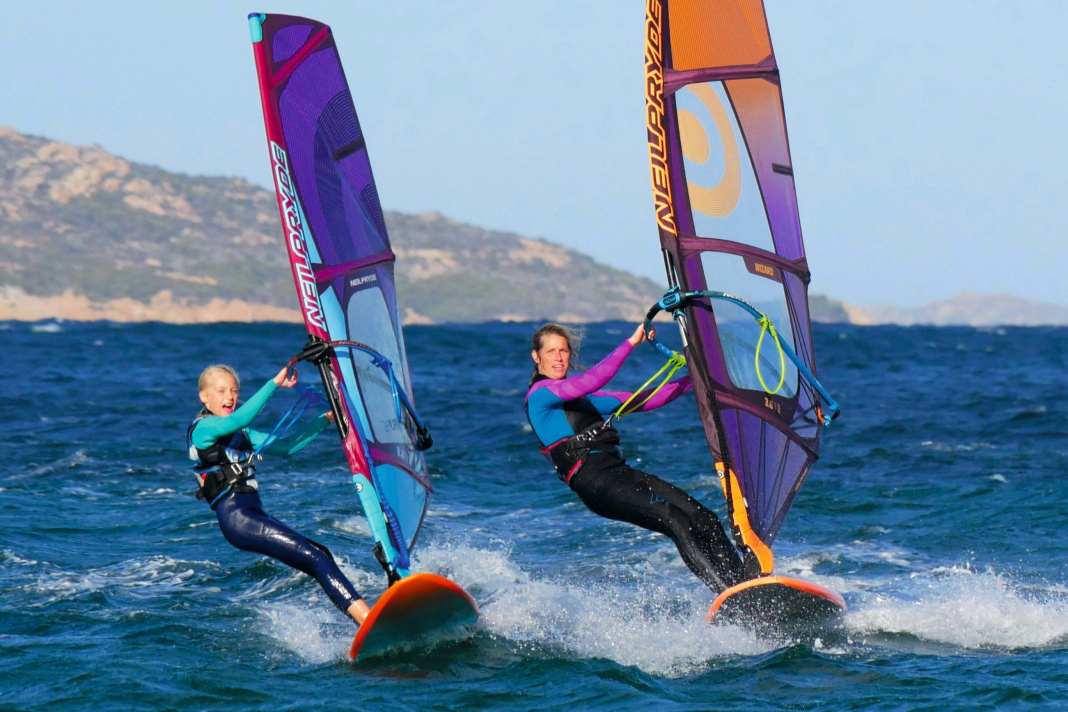Probably 90 per cent of all skiers spent their first days on skis in ski school. On the piste, this is almost standard. Things are often different on the beach. At least if the parents surf themselves, "home schooling" is often the order of the day. After all, you are half a jibe god yourself and will teach your children how to do it.
More about windsurfing for children:
"I see this a lot and unfortunately it often goes wrong," says surf editor and VDWS instructor Manuel Vogel, "especially if the parents have no experience of how to teach. If a parent has learnt how to do it, I think it works. But experience has shown that there is always a difference between someone external teaching the children and their own parents. There are also incentives such as the reward system in a school - with certificates and different levels that can be achieved. Most children think it's cool when they find out when they sign up that they can get a surfing licence at the end."
Which doesn't mean that children learning privately with their parents can't be fun. On the contrary. Ideally, it can be a wonderful experience together with other children. Perhaps parents who are friends with their children also look after them "crosswise"? Because who hasn't experienced it: the same advice - five times from the parents or just once from another person - is often evaluated and followed completely differently in the children's world. And "when peers are involved, frustration doesn't arise so quickly. The children see that the others can't do everything straight away either. At least that's how it is with my children. If, on the other hand, we're on our own, they often get fed up very quickly," Manuel has realised.
The right windsurfing equipment for children
Unfortunately, the right equipment is often a problem. Of course, this special is also intended to help you find the right equipment for the next generation. Christian Winderlich from the Norderney surf school also takes a look at the equipment notch. Naturally with the ulterior motive of a surf school operator, but also with understandable arguments: "A good school simply always has the right equipment for every wind, so a six-year-old can surf with a 1.0 sail in six wind forces. And experienced surf instructors know how to teach the right technique. Many adult surfers use sails that are too big because they have never learnt how to balance properly. And that starts with the children, a surf instructor has to see and train that."
Sails that are too big and boards that are too small are the most common mistakes." (Christian Winderlich, Surf School Norderney)
Around 120 children learn to surf at the Norderney surf school during the high season - every week. That's why Christian knows all the big problems, but also the smallest ones: "The biggest hurdles are sails that are too big and boards that are too small. You should definitely buy a children's sail, because even a 3.7 adult sail is not easy for children to put up. The water should also be shallow and the wind should not blow offshore. Fun boards are also possible, but always with a very small fin at the back and a daggerboard or centre fin. SUPs with round edges without a centre fin are not suitable."
Parents are happy to help at the beginning and hold the board, but according to Christian, you have to make a fine distinction here too: "Stabilising around the axis is okay, holding on is not. Then you don't learn to balance and can't steer. You can also help to bring the sail into the right position, but you have to know what you're doing."
Learning is more fun in a group
For Christian, however, the best catalyst for activating the surfing virus is learning in a group: "If parents are trained in how to teach windsurfing, it can work well, but it might work better in a group of peers. Children don't compare themselves so much, that's stronger with teenagers, who also get frustrated more easily. Children also look at the other children, but mainly learn in the process." And, of course, Christian also recognises the psychological advantage of the "foreign" surf instructor. "Parents sometimes ask in amazement how you managed to get the little one to carry his board himself or put on his wetsuit, because he never does that otherwise."
Children are often pretty brave, but at heart they are all pretty cold-blooded. Good protection against the cold is at least as important as the right sail and board. Even in summer temperatures in Croatia, a long john should at least protect the children: From cooling down in the wind, but also from the sun and with the long legs, the knees in particular are better protected than in the popular shorty. The classic with the long legs offers clear advantages here. And with a tight-fitting long-sleeved suit in the right size and 5/3 or 5/4 millimetre thickness and warm surfing shoes, there's hardly anything standing in the way of hours of fun in the water.
I can only advise you to keep at it until you're really gliding. Because flying over the water is the very best thing for me!" (Melli, nine years old)
Becoming a windsurfing freak in three phases
An extraordinary case shows what is possible with optimal supervision: Miriam Küppers (photo left with daughter Melli) is not only obsessed with windsurfing herself, but has also got her children onto the boom, foot straps, harness and their first freestyle tricks at record speed. In three methodical stages, Miriam got the kids gliding at the age of four.
- In phase one, still together on a large board (also on iSUPs), the instructor sits in front of the rig and helps to hoist the sail and secretly stabilises the rig. This prevents drifting and exhaustion.
- In phase two, the children's board is towed from the instructor's board with a rubber rope (attached to the base plate) and the course is stabilised. For motivational boosts between sessions, gliding between dad's legs (above) is a good way to show what's worth learning for.
- Phase three is then "getting airborne", surfing alone and fighting your way through.
And the spark has more than just been ignited. Miriam's daughter Melli, now nine years old, is already passing on the fire, "is already coaching her four-year-old sister Neli in glide surfing and has a message for all kids: 'Keep at it until you're really gliding, because flying over the water is the very best thing!"






